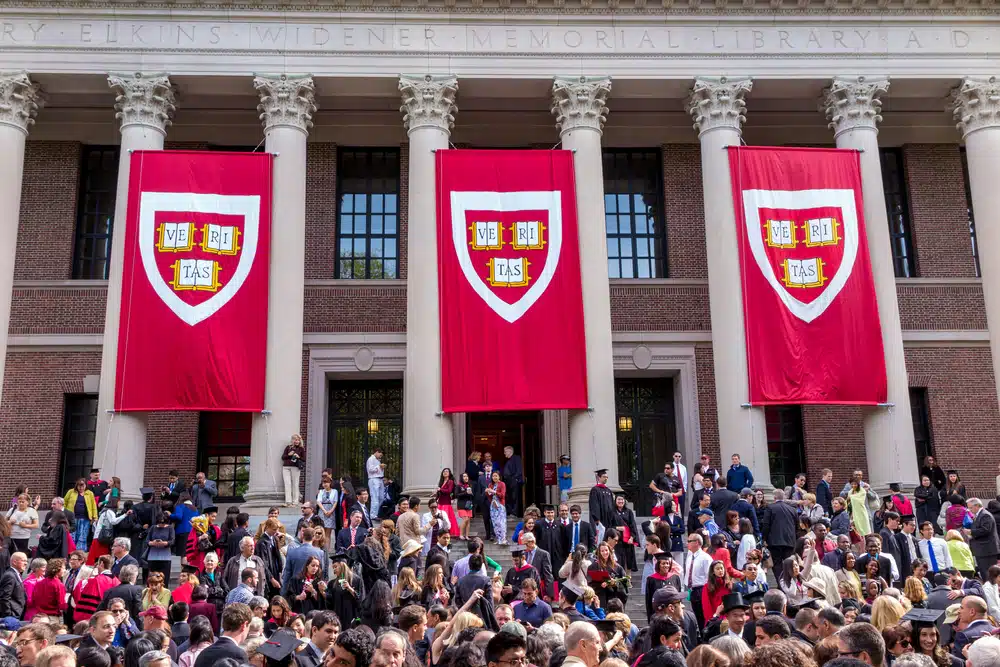Unveiling the Harvard Admissions Statistics
Understanding the Significance of Harvard’s Admission Rate
Over the years, when we take a look at Harvard admissions statistics, its admission rate is one of the lowest in the United States, with only 4% of applicants gaining admission to the institution. Harvard is committed to admitting only the best of the best applicants who have demonstrated their academic prowess and potential in their high school careers.
Furthermore, Harvard’s admission process is highly selective and holistic, taking into account not only academic achievements but also extracurricular activities, personal qualities, and potential contributions to the university community. The admissions committee also considers factors such as socioeconomic background, race, and ethnicity to ensure a diverse and inclusive student body.
Therefore, while the Harvard admissions statistics may seem daunting, it is important to remember that Harvard values a well-rounded and diverse student body, and each applicant is evaluated on their unique strengths and potential.
The Demographic Breakdown of Harvard’s Student Body
Despite the Harvard admissions statistics showcasing consistently low rates, Harvard University’s student body is highly diverse. With students coming from all walks of life, the university prides itself on its commitment to admitting qualified students from all backgrounds, and this can be seen in the diversity of the student body.
In 2021, 50.7% of the admitted students were women, and 20% were either first-generation or historically underserved students. In addition, the admitted students came from 49 states in the U.S. and at least 90 countries worldwide.
Harvard University also has a strong commitment to promoting diversity and inclusion on campus. The university has various programs and initiatives aimed at creating a welcoming and inclusive environment for all students. For instance, the Office of Diversity, Inclusion, and Belonging offers resources and support for students from underrepresented backgrounds, including LGBTQ+ students, students with disabilities, and students of color.
How Harvard’s Admissions Process Has Evolved Over the Years
One thing that greatly affects Harvard admissions statistics is the admissions process. Over the years, the admissions process for Harvard has continued to evolve in response to societal and educational changes. The emphasis on holistic admissions, where more attention is given to extracurricular activities and community involvement, is a recent development in the admissions process.
These changes are a response to the needs of a changing society. They are designed to ensure that Harvard admits individuals who are not only academically excellent but also possess qualities essential to the well-rounded and diverse student body that Harvard University is known for.
One significant change in Harvard’s admissions process is the increased focus on diversity and inclusion. In recent years, Harvard has made a concerted effort to increase the representation of underrepresented groups, such as students from low-income backgrounds and students of color. This has included changes to the admissions process, such as the removal of early action and the implementation of a test-optional policy.
Additionally, Harvard has increased its outreach efforts to high schools and community organizations serving underrepresented students, encouraging more diverse applicants to apply.
The Academic Credentials of Admitted Students
Academically, admitted students at Harvard have some of the highest test scores and grades in the country. The average SAT score for admitted students is 1480 – 1580, and the average ACT score is 33 – 36. In addition to test scores, the admissions committee also considers high school grades, academic rigor, letters of recommendation, and personal essays when evaluating candidates. The most essential factor in the admissions decision, however, is often a candidate’s intellectual curiosity and demonstrated passion for learning.
Furthermore, the university actively seeks out students who have overcome challenges or obstacles in their lives and have demonstrated resilience and determination.
Once admitted, students at Harvard have access to a wealth of academic resources and opportunities. The university offers over 3,700 courses across a wide range of disciplines, and students can also take advantage of research opportunities, internships, and study abroad programs.
Additionally, Harvard has a robust support system in place to help students succeed, including academic advisors, tutoring services, and mental health resources.
The Role of Extracurricular Activities in the Admissions Process
Extracurricular activities, community service, and leadership roles are all qualities that are highly valued in the admissions process at Harvard. These activities demonstrate a candidate’s ability to excel in areas outside the classroom and their commitment to making a positive impact on their community. Students who have made meaningful contributions to their communities and who have a demonstrated commitment to social justice are often given higher consideration during the admissions process.
It is important to note that the quality of extracurricular activities is more important than the quantity. Admissions officers are looking for depth and commitment in a student’s extracurricular pursuits, rather than a long list of activities with minimal involvement. Additionally, students who have overcome challenges or obstacles in their pursuit of extracurricular activities are often viewed favorably in the admissions process, as it demonstrates resilience and determination.
Comparing Harvard’s Admissions Statistics to Other Ivy League Schools
When it comes to Ivy League admissions, Harvard is not the only institution that receives a large number of impressive applications. Schools such as Princeton, Yale, and Columbia all have relatively low acceptance rates.
Students can apply to multiple Ivy League schools. However, each institution has different evaluation criteria. Thus, applicants need to understand what each school is looking for in potential students.
One factor that sets Harvard apart from other Ivy League schools is its emphasis on extracurricular activities. While all Ivy League schools value well-rounded applicants, Harvard places a particular emphasis on extracurricular involvement. This means that applicants who have demonstrated leadership and impact in their extracurricular activities may have an advantage in the admissions process.
Another factor to consider when comparing Harvard admissions statistics to other Ivy League admissions statistics is the impact of legacy status. Legacy applicants are those who have a family member who attended the institution. While all Ivy League schools consider legacy status in their admissions process, the extent to which it is a factor varies. At Harvard, legacy status is considered, but it is not a guarantee of admission. Other Ivy League schools place a greater emphasis on legacy status in their admissions decisions.
The Impact of Legacy Status on Admissions Decisions
Legacy status, which means having a relative who previously attended Harvard, has been a topic of discussion in the admissions process for years. While legacy status is not the deciding factor in admissions decisions, it is an advantage for applicants. Legacy applicants are admitted at a higher rate than non-legacy applicants, but they still need to meet the same academic qualifications as all other applicants.
However, there has been a growing debate about the fairness of legacy admissions. Critics argue that it perpetuates privilege and reinforces social inequality, as legacy applicants are often from wealthy and influential families. On the other hand, supporters of legacy admissions argue that it helps to maintain a strong alumni network and fosters a sense of tradition and loyalty to the institution.
The Impact of Ethnicity and Race on Admissions Decisions at Harvard
Race and ethnicity are essential factors in the admissions process at Harvard, as the institution is committed to creating a diverse student body. However, applicants’ race or ethnicity alone will not guarantee admission to the university. Harvard takes a holistic approach to admissions, considering a candidate’s entire profile before making an admissions decision. The university seeks to advance its mission of creating a diverse community of scholars who can collaborate across a range of perspectives and experiences.
Harvard’s admissions process takes into account the historical and societal context of an applicant’s race and ethnicity. The university recognizes that certain groups have faced systemic barriers to education and opportunities, and therefore, may have had different experiences and opportunities than others. This context is considered when evaluating an applicant’s achievements and potential.
In addition to race and ethnicity, Harvard also considers other factors such as academic achievement, extracurricular activities, personal qualities, and life experiences. The university seeks to admit students who will contribute to the campus community and who have the potential to make a positive impact on the world. Ultimately, the admissions process at Harvard is designed to identify and admit the most talented and promising students, regardless of their background.
Exploring the Acceptance Rates of Different Academic Programs at Harvard
Harvard offers a wide range of academic programs in various fields of study. The admissions rate for each program varies depending on the popularity and competitiveness of the program.
For example, the acceptance rate for the Computer Science program is much lower than the acceptance rate for the Classics program. It’s essential to note that admissions decisions are based on qualifications and fit for the program and not on the specific major that a student intends to study.
Another factor that affects Harvard admissions statistics is the number of available spots in each program. Some programs have a limited number of spots available, which makes them more competitive.
For instance, the acceptance rate for the Medical School program is much lower than the acceptance rate for the Education program due to the limited number of spots available in the former.
It’s also worth noting that the acceptance rates for different academic programs at Harvard can vary from year to year. The admissions committee considers various factors when making admissions decisions, including the number of applicants, the quality of the applications, and the needs of the program. Therefore, the acceptance rate for a particular program in one year may not be the same as the acceptance rate for the same program in another year.
How International Students Fare in the Admissions Process at Harvard
Harvard admits students from all over the world, with international students comprising around 12.4% of the admitted class of 2021. International students face additional requirements during the admissions process, such as language proficiency tests, but ultimately, they are judged by the same admissions criteria as domestic applicants. Admissions decisions for international students are based on academic qualifications, extracurricular activities, and demonstrated interest in attending Harvard University.
One challenge that international students may face during the admissions process is the need to navigate the complex visa application process. Harvard provides support and resources to help international students with this process, but it can still be a daunting task for many.
Additionally, international students may face cultural and social adjustments when coming to study at Harvard, such as adapting to a new academic system and making new friends in a foreign country.
Despite these challenges, international students bring a unique perspective and diversity to the Harvard community. They enrich the academic and cultural experiences of their peers and contribute to the global reach and impact of the university. Harvard values the contributions of international students and is committed to providing them with the resources and support they need to succeed both academically and personally.
Analyzing the Impact of Financial Aid on Admissions Decisions at Harvard
Harvard is committed to providing access to post-secondary education for qualified students regardless of their financial status. The university has a need-blind admissions process, meaning that an applicant’s financial status does not impact their admissions decision. In addition, Harvard meets the full demonstrated financial need of admitted students, ensuring that all students who are admitted to the institution can afford to attend.
Recent studies have shown that the availability of financial aid can have a significant impact on a student’s decision to apply to and attend a particular institution. Harvard’s commitment to meeting the full demonstrated financial need of admitted students has resulted in a diverse student body, with students from a wide range of socioeconomic backgrounds. This commitment to financial aid has also allowed Harvard to attract and retain top talent, as students can focus on their studies and extracurricular activities without the burden of financial stress.
The Role of Demonstrated Interest in the Admissions Process at Harvard
Demonstrated interest refers to a candidate’s interest in attending Harvard. Engaging with the university through attending college fairs, visiting the campus, and participating in information sessions are ways that prospective students can demonstrate their interest in attending the university.
While demonstrated interest is not a formal requirement for admissions, it can positively impact an applicant’s application. It shows that a student is committed to attending the university, and this can be factored into the admissions decision.
Furthermore, demonstrated interest can also be a way for prospective students to learn more about the university and determine if it is the right fit for them. By attending information sessions and visiting the campus, students can gain a better understanding of the university’s culture, academic programs, and resources. This can help them make an informed decision about whether or not to apply to Harvard, and ultimately, whether or not to attend if accepted.
Conclusion
In conclusion, the admissions process at Harvard University is a highly competitive process that takes a holistic approach to evaluating potential candidates. While test scores and grades are important, extracurricular activities, community service, and demonstrated interest in attending the university are also essential factors in the admissions process.
The university is committed to creating a diverse student body, and it does so by evaluating each candidate’s qualifications and fit for the institution. While the Harvard admissions statistics show that the admissions process is rigorous, being admitted to Harvard is a tremendous honor and an achievement that can be a stepping stone toward a successful and fulfilling career.








































